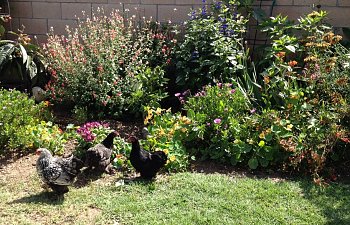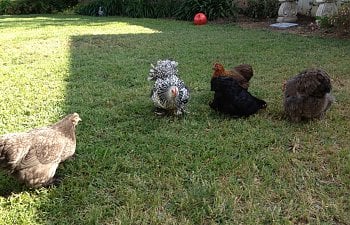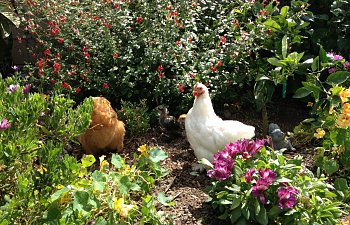Having a nice yard and garden as well as eating fresh homegrown produce is something many of us enjoy, including most backyard chickens. When I first started keeping chickens, I didn't realize how much damage they could do. After trial and error and a bit of advice from other gardeners with chickens here at BYC, I have learned a nice garden and chickens CAN co-exist. Here are a few of my favorite gardening practices for keeping chickens, but still having a productive pretty garden for the family.
UPDATE: For pictures 2014-2021 and other info on my successful methods to gardening with chickens please visit my blog @ hanburyhouse.com
(Photos in this page were taken this April 2012, after 4 years with chickens running around my backyard pretty regularly.)


Grass is a favorite chicken food to nibble on while out in the backyard

Two of the mama hens are out for a walk with the chicks in the perennial flowers in the backyard. The bigger plants, like the shrubs and fruit trees give them places to dart into to hide when spooked
UPDATE: For pictures 2014-2021 and other info on my successful methods to gardening with chickens please visit my blog @ hanburyhouse.com
(Photos in this page were taken this April 2012, after 4 years with chickens running around my backyard pretty regularly.)

- Don't keep more chickens than you really need. The more chickens you have, the greater their impact on the garden and the more damage you get.
- Fence off the vegetable garden with permanent fencing.
- Experiment and never buy a ton of anything to start with. When trying a new plant in the yard, I often will leave a newly purchased potted plant where the hens can nibble. If they ignore it for a few days, in the ground it goes the following week.
- Hungry chickens will eventually eat almost any plants if there is nothing else to forage around or no other good food source. Make sure there is something you are okay with them munching on if you let them free range. I have a modest amount of grass in the backyard that my hens nibble on throughout the day as well as many fast grow annuals in the Spring, so they are never at loss for green stuff. Plus, they always have access to their feeder and water.
- Check toxicity levels before planting anything. Chickens don’t normally bother poisonous plants unless they have nothing else to choose from, but also try avoid planting stuff that is deadly like foxglove or oleander.
- Don't give the chickens all day access to the yard. One popular practice is to let the chickens out in the late afternoon and then they often will put them selves back in the coop at dusk.
- Temporarily fence chickens out of newly planted or fragile areas with chicken wire or other portable fencing until the plants have a chance to get established.
- Add scraps of chicken wire around the base of plants when first planting them and then cover with mulch. This prevents chickens from accidentally scratching them out before they are firmly established or damaging the fragile surface roots. It works with dogs too.
- Invest in and plant more fruit trees, shrubs, and woody perennials to provide “bones” to the garden so it doesn’t look bare and gives the chickens a place to hide in the event a hawk comes by for a visit.
- Feather footed bantam breeds, like Cochins (Pekins,) Brahmas, and Silkies are often ideal breeds for fussy gardeners.

Grass is a favorite chicken food to nibble on while out in the backyard

Two of the mama hens are out for a walk with the chicks in the perennial flowers in the backyard. The bigger plants, like the shrubs and fruit trees give them places to dart into to hide when spooked
